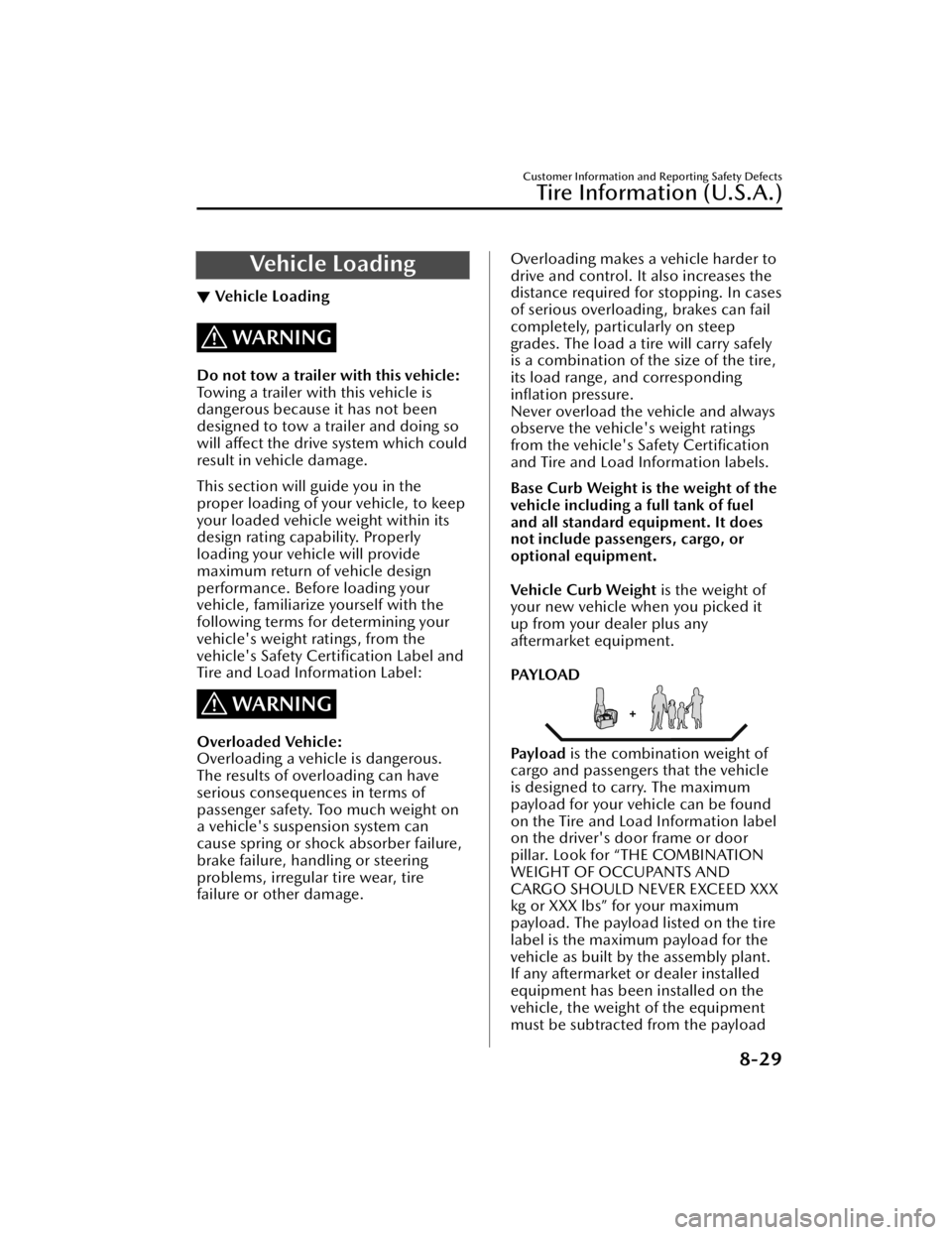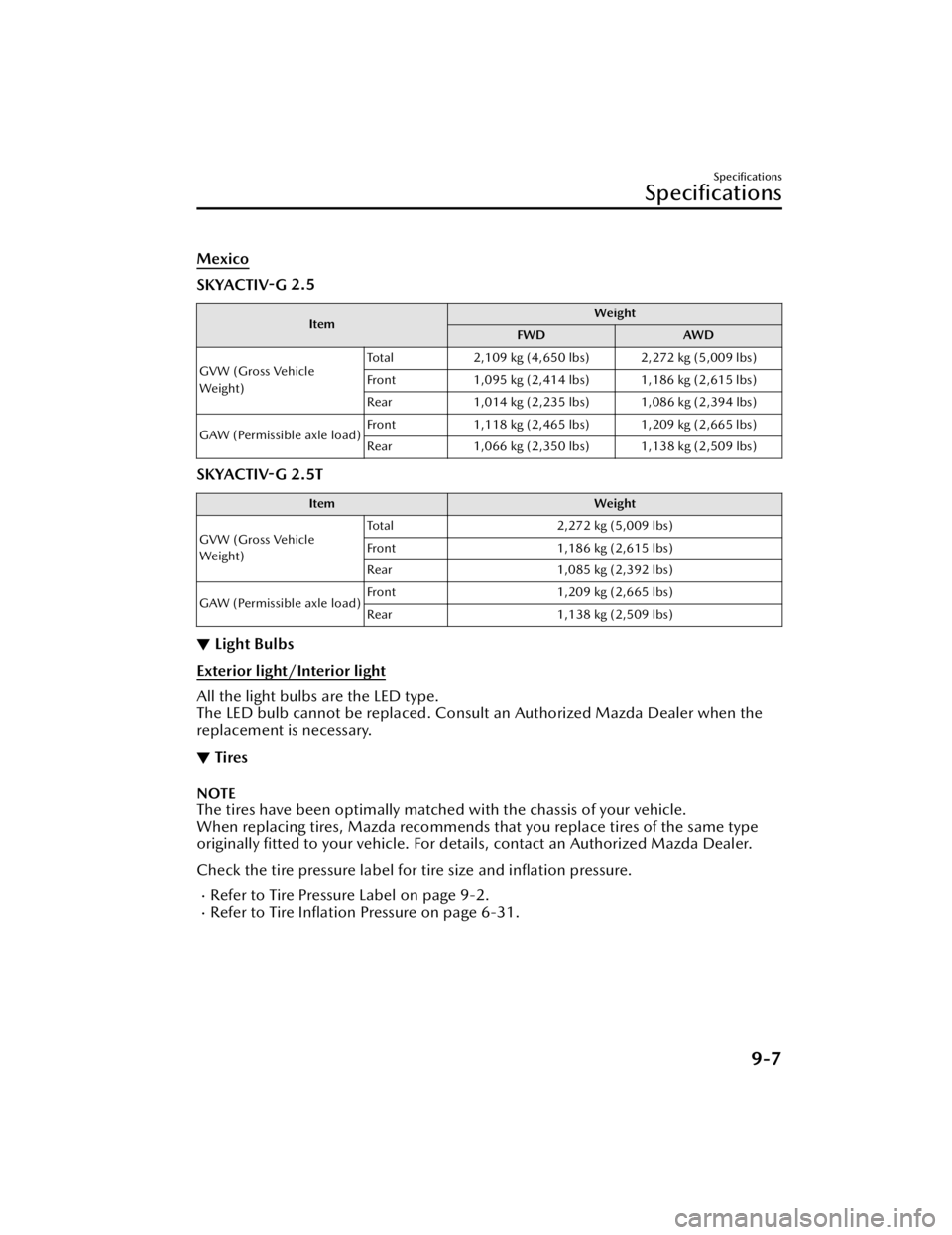tire size MAZDA CX5 2023 Owner's Manual
[x] Cancel search | Manufacturer: MAZDA, Model Year: 2023, Model line: CX5, Model: MAZDA CX5 2023Pages: 583, PDF Size: 32.58 MB
Page 543 of 583

Tire Labeling
▼Tire Labeling
Federal law requires tire manufacturers
to place standardized information on
the sidewall of all tires. This
information identifies and describes
the fundamental characteristics of the
tire and also provides a tire
identification
number for safety
standard certification and in case of a
recall.
▼ Information on Passenger Vehicle
Tires
Please refer to the sample below.
1. SAFETY WARNING
2. Passenger car tire
3. Nominal width of tire in millimeters
4. Ratio of height to width (aspect
ratio)
5. Radial
6. Run-flat tire
7. Rim diameter code
8. TIN: U.S. DOT tire
identification
number
9. Load index & speed symbol
10.Severe snow conditions
11.Tire ply composition and materials used
12.Max. load rating
13.Tread wear, traction and temperature grades
14.Max. permissible inflation pressure
P215/65R15 95H is an example of a
tire size and load index rating. Here is
an explanation of the various
components of that tire size and load
index rating. Note that the tire size and
load index rating may be different from
the example.
P
Indicates a tire that may be installed on
cars, SUVs, minivans and light trucks as
designated by the Tire and Rim
Association (T&RA).
NOTE
If your tire size does not begin with a
letter this may mean it is designated by
either ETRTO (European Tire and Rim
Technical Organization) or JATMA
(Japan Tire Manufacturing
Association).
215
“215” is the nominal width of the tire
in millimeters. This three-digit number
gives the width in millimeters of the
tire from sidewall edge to sidewall
edge. In general, the larger the
number, the wider the tire.
65
“65” is the aspect ratio. This two-digit
number indicates the tire's ratio of
height to width.
R
“R” is the tire construction symbol. R
indicates “Radial ply construction”.
15
“15” is the wheel rim diameter in
inches.
Customer Information and Reporting Safety Defects
Tire Information (U.S.A.)
8-22
CX-50_8KB8-EA-22A_Edition2_new 2022-1-6 14:55:18
Page 545 of 583

The grades represent the tire's ability
to stop on wet pavement as measured
under controlled conditions on
specified government test surfaces of
asphalt and concrete. A tire marked C
may have poor traction performance.
Temperature: The temperature grades
are A (the highest), B and C,
representing the tire's resistance to the
generation of heat and its ability to
dissipate heat when tested under
controlled conditions on a specified
indoor laboratory test wheel.
Snow Tires
In some heavy snow areas, local
governments may require true snow
tires, those with very deeply cut tread.
These tires should only be used in pairs
or placed on all four wheels. Make
sure you purchase snow tires that are
the same size and construction type as
the other tires on your vehicle.
SAFETY WARNING
The following safety warning appears
on the tire's sidewall.
SERIOUS INJURY MAY RESULT FROM:
EXPLOSION OF TIRE/RIM ASSEMBLY
DUE TO IMPROPER
MOUNTING-MATCH TIRE
DIAMETER TO RIM DIAMETER;
NEVER EXCEED 40 psi (275 kPa) TO
SEAT BEADS-ONLY SPECIALLY
TRAINED PERSONS SHOULD
MOUNT TIRES.
TIRE FAILURE DUE TO UNDER-INFLATION/
OVERLOADING/DAMAGE-FOLLOW
OWNER'S MANUAL AND PLACARD
IN VEHICLE-FREQUENTLY CHECK
INFLATION PRESSURE AND INSPECT
FOR DAMAGE.
▼ Information on Temporary Tires
Please refer to the sample below.
1. Temporary tires
2. Nominal width of tire in millimeters
3. Ratio of height to width (aspect
ratio)
4. Diagonal
5. Rim diameter code
6. Load index & speed symbol
T115/70D16 90M is an example of a
tire size and load index rating. Here is
an explanation of the various
components of that tire size and load
index rating. Note that the tire size and
load index rating may be different from
the example.
T
Indicates a tire that may be installed on
cars, SUVs, minivans and light trucks as
designated by the Tire and Rim
Association (T&RA).
115
“115” is the nominal width of the tire
in millimeters. This three-digit number
gives the width in millimeters of the
tire from sidewall edge to sidewall
edge. In general, the larger the
number, the wider the tire.
Customer Information and Reporting Safety Defects
Tire Information (U.S.A.)
8-24
CX-50_8KB8-EA-22A_Edition2_new 2022-1-6 14:55:18
Page 546 of 583

70
“70” is the aspect ratio. This two-digit
number indicates the tire's ratio of
height to width.
D
“D” is the tire construction symbol. D
indicates “diagonal ply construction”.
16
“16” is the wheel rim diameter in
inches.
90
“90” is the Load Index. This two-or
three-digit number indicates how
much weight each tire can support.
M
“M” is the speed rating. The speed
rating denotes the maximum speed for
which the use of the tire is rated.
Letter Rating Speed Rating
M 81 mph
Location of the Tire Label (Placard)
▼Location of the Tire Label (Placard)
You will find the tire label containing
tire
inflation pressure by tire size and
other important information on the
driver's side B-pillar or on the edge of
the driver's door frame.
SAMPLE
▼ Recommended Tire Inflation
Pressure
On the tire label you will find the
recommended tire
inflation pressure in
both kPa and psi for the tires installed
as original equipment on the vehicle. It
is very important that the inflation
pressure of the tires on your vehicle is
maintained at the recommended
pressure. You should check the tire
pressure regularly to insure that the
proper inflation pressure is maintained.
Refer to Tires on page 9-7.
NOTE
Tire pressures listed on the vehicle
placard or tire information label
indicate the recommended cold tire
inflation pressure, measured when the
tires are cold, after the vehicle has
been parked for at least 3 hours. As
you drive, the temperature in the tire
warms up, increasing the tire pressure.
Customer Information and Reporting Safety Defects
Tire Information (U.S.A.)
8-25
CX-50_8KB8-EA-22A_Edition2_new 2022-1-6 14:55:18
Page 547 of 583

WARNING
Always check the tire inflation
pressures on a regular basis according
to the recommended tire inflation
pressure on the tire label and in
conjunction with the information in
this owner's manual:
Driving your vehicle with
under-inflated tires is dangerous.
Under-inflation is the most common
cause of failures in any kind of tire and
may result in severe cracking , tread
separation or “blowout”, with
unexpected loss of vehicle control and
increased risk of injury. Under-inflation
increases sidewall flexing and rolling
resistance, resulting in heat buildup
and internal damage to the tire. It
results in unnecessary tire stress,
irregular wear, loss of control and
accidents. A tire can lose up to half of
its air pressure and not appear to be
flat!
It is impossible to determine whether
or not tires are properly inflated just by
looking at them.
▼ Checking Tire Pressure
1. When you check the air pressure,
make sure the tires are cold
―meaning they are not hot from
driving even a mile.
2. Remove the cap from the valve on
one tire.
3. Firmly press a tire gauge onto the valve.
4. Add air to achieve recommended air pressure.
5. If you overfill the tire, release air by pushing on the metal stem in the
center of the valve. Then recheck
the pressure with your tire gauge.
6. Replace the valve cap.
7. Repeat with each tire, including the spare.
NOTE
Some spare tires require higher
inflation pressure.
8. Visually inspect the tires to make sure there are no nails or other
objects embedded that could poke
a hole in the tire and cause an air
leak.
9. Check the sidewalls to make sure there are no gouges, cuts, bulges,
cracks or other irregularities.
▼Glossary of Terms
Tire Placard:
A label indicating the OE
tire sizes, recommended inflation
pressure, and the ma ximum weight the
vehicle can carry.
Tire Identification Number (TIN): A
number on the sidewall of each tire
providing information about the tire
brand and manufacturing plant, tire
size, and date of manufacture.
Inflation Pressure: A measure of the
amount of air in a tire.
kPa: Kilopascal, the metric unit for air
pressure.
psi: Pounds per square inch, the
English unit for air pressure.
B-pillar: The structural member at the
side of the vehicle behind the front
door.
Original Equipment (OE): Describes
components originally equipped on
the vehicle.
Ve h i c l e L o a d L i m i t : The maximum
value of the combination weight of
occupants and cargo.
Bead Area of the Tire: Area of the tire
next to the rim.
Sidewall Area of the Tire: Area
between the bead area and the tread.
Trea d A rea o f t h e Ti re : Area on the
perimeter of the tire that contacts the
Customer Information and Reporting Safety Defects
Tire Information (U.S.A.)
8-26
CX-50_8KB8-EA-22A_Edition2_new 2022-1-6 14:55:18
Page 550 of 583

Ve h i c l e L o a d i n g
▼Ve h i c l e L o a d i n g
WARNING
Do not tow a trailer with this vehicle:
Towing a trailer with this vehicle is
dangerous because it has not been
designed to tow a trailer and doing so
will
affect the drive system which could
result in vehicle damage.
This section will guide you in the
proper loading of your vehicle, to keep
your loaded vehicle weight within its
design rating capability. Properly
loading your vehicle will provide
maximum return of vehicle design
performance. Before loading your
vehicle, familiarize yourself with the
following terms for determining your
vehicle's weight ratings, from the
vehicle's Safety Certification Label and
Tire and Load Information Label:
WARNING
Overloaded Vehicle:
Overloading a vehicle is dangerous.
The results of overloading can have
serious consequences in terms of
passenger safety. Too much weight on
a vehicle's suspension system can
cause spring or shock absorber failure,
brake failure, handling or steering
problems, irregular tire wear, tire
failure or other damage.
Overloading makes a vehicle harder to
drive and control. It also increases the
distance required for stopping. In cases
of serious overloading, brakes can fail
completely, particularly on steep
grades. The load a tire will carry safely
is a combination of the size of the tire,
its load range, and corresponding
inflation pressure.
Never overload the vehicle and always
observe the vehicle's weight ratings
from the vehicle's Safety Certification
and Tire and Load Information labels.
Base Curb Weight is the weight of the
vehicle including a full tank of fuel
and all standard equipment. It does
not include passengers, cargo, or
optional equipment.
Vehicle Curb Weight is the weight of
your new vehicle when you picked it
up from your dealer plus any
aftermarket equipment.
PAY LOA D
Pay l o a d is the combination weight of
cargo and passengers that the vehicle
is designed to carry. The maximum
payload for your vehicle can be found
on the Tire and Load Information label
on the driver's door frame or door
pillar. Look for “THE COMBINATION
WEIGHT OF OCCUPANTS AND
CARGO SHOULD NEVER EXCEED XXX
kg or XXX lbs” for your maximum
payload. The payload listed on the tire
label is the maximum payload for the
vehicle as built by the assembly plant.
If any aftermarket or dealer installed
equipment has been installed on the
vehicle, the weight of the equipment
must be subtracted from the payload
Customer Information and Reporting Safety Defects
Tire Information (U.S.A.)
8-29
CX-50_8KB8-EA-22A_Edition2_new 2022-1-6 14:55:18
Page 572 of 583

Mexico
SKYACTIV-G 2.5
Item Weight
FWD AWD
GVW (Gross Vehicle
Weigh t ) Total
2,109 kg (4,650 lbs) 2,272 kg (5,009 lbs)
Front 1,095 kg (2,414 lbs) 1,186 kg (2,615 lbs)
Rear 1,014 kg (2,235 lbs) 1,086 kg (2,394 lbs)
GAW (Permissible axle load) Front
1,118 kg (2,465 lbs) 1,209 kg (2,665 lbs)
Rear 1,066 kg (2,350 lbs) 1,138 kg (2,509 lbs)
SKYACTIV-G 2.5T
Item Weight
GVW (Gross Vehicle
Weigh t ) Total
2,272 kg (5,009 lbs)
Front 1,186 kg (2,615 lbs)
Rear 1,085 kg (2,392 lbs)
GAW (Permissible axle load) Front
1,209 kg (2,665 lbs)
Rear 1,138 kg (2,509 lbs)
▼Light Bulbs
Exterior light/Interior light
All the light bulbs are the LED type.
The LED bulb cannot be replaced. Consult an Authorized Mazda Dealer when the
replacement is necessary.
▼Tires
NOTE
The tires have been optimally matched with the chassis of your vehicle.
When replacing tires, Mazda recommends that you replace tires of the same type
originally fitted to your vehicle. For details, contact an Authorized Mazda Dealer.
Check the tire pressure label for
tire size and inflation pressure.
Refer to Tire Pressure Label on page 9-2.Refer to Tire Inflation Pressure on page 6-31.
Specifications
Specifications
9-7
CX-50_8KB8-EA-22A_Edition2_new 2022-1-6 14:55:18
Page 573 of 583

Standard tire
(U.S.A. and Canada)
Tire sizeInflation pressure
Front Rear
225/65R17 102H 250 kPa (36 psi)250 kPa (36 psi)
245/45R20 99V 240 kPa (35 psi)240 kPa (35 psi)
(Mexico)
Tire size Inflation pressure
Front Rear
225/65R17 102H 250 kPa (2.5 bar, 36 psi) 250 kPa (2.5 bar, 36 psi)
245/45R20 99V 240 kPa (2.4bar, 35 psi) 240 kPa (2.4bar, 35 psi)
Temporary spare tire
(U.S.A. and Canada)
Tire size Inflation pressure
T155/90D17 101M 420 kPa (60 psi)
(Mexico)
Tire sizeInflation pressure
185/80R17 99M 320 kPa (3.2 bar, 46 psi)
Lug nut tightening torque
When installing a tire, tighten the lug nut to the following torque.
108―147 N·m (12―14 kgf·m, 80―108 ft·lbf)
▼Fuses
Refer to Fuses on page 6-35.
Specifications
Specifications
9-8
CX-50_8KB8-EA-22A_Edition2_new
2022-1-6 14:55:18